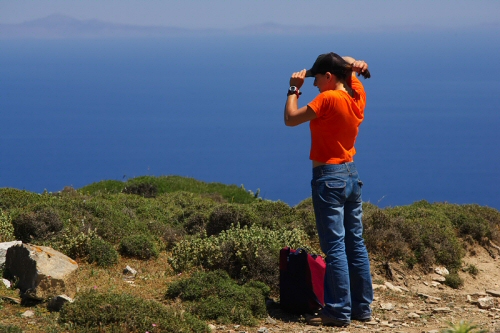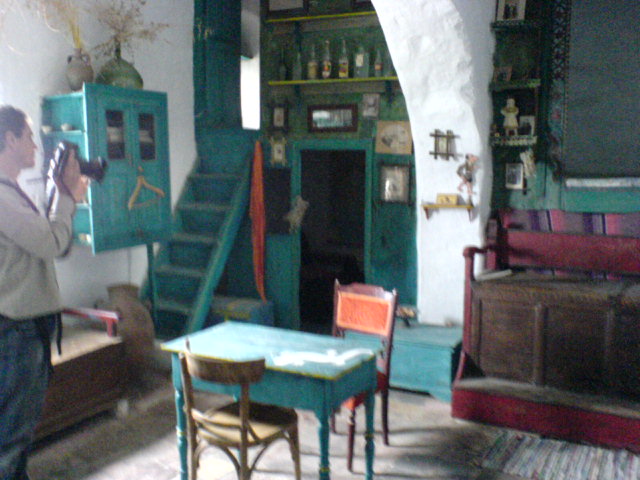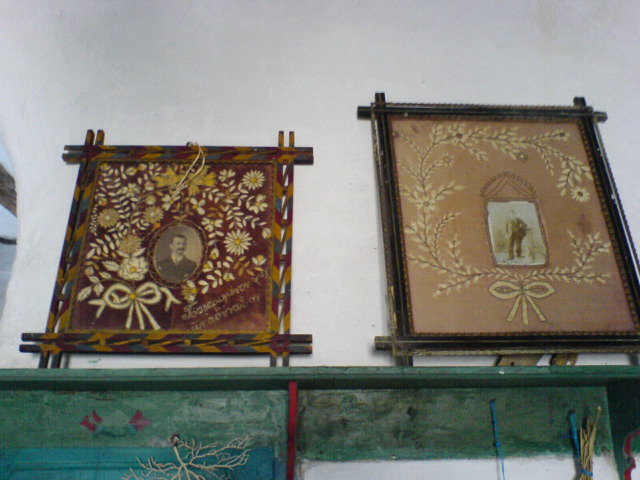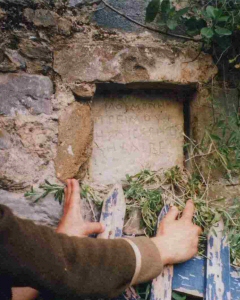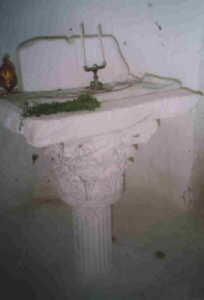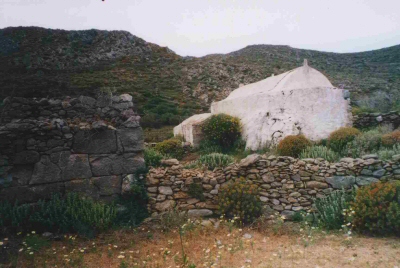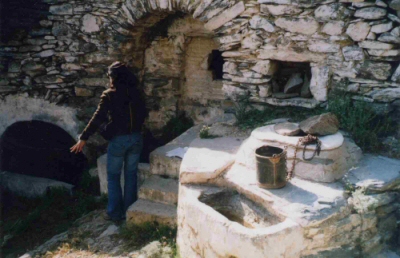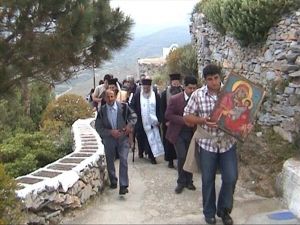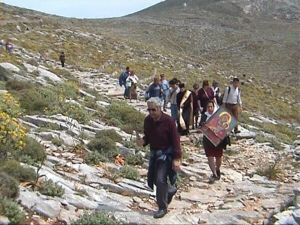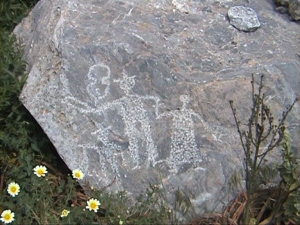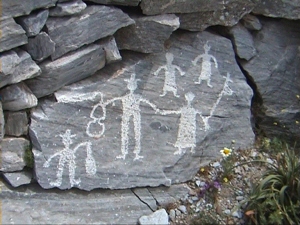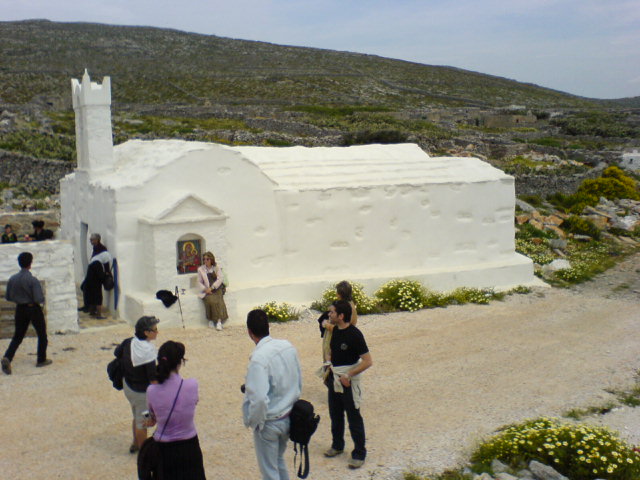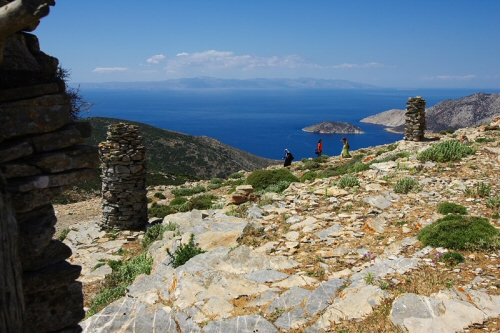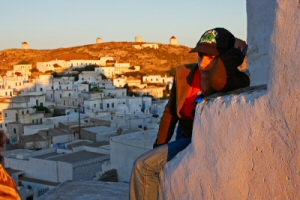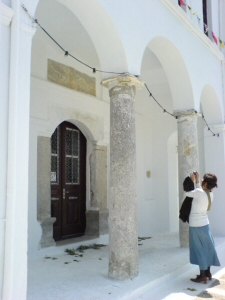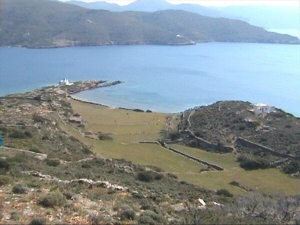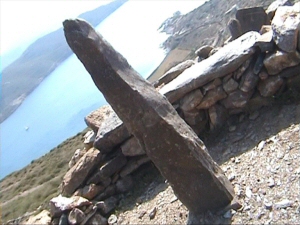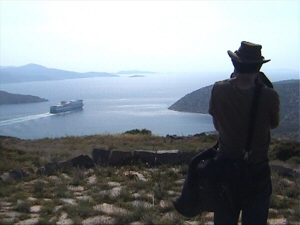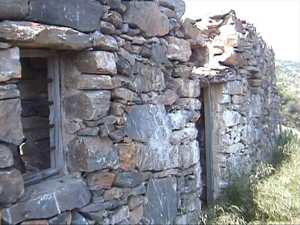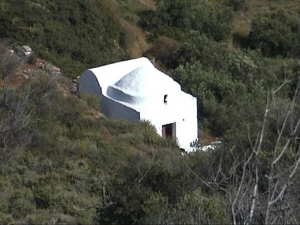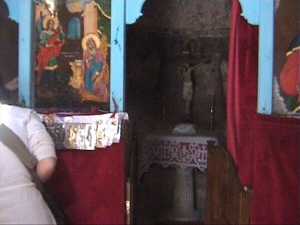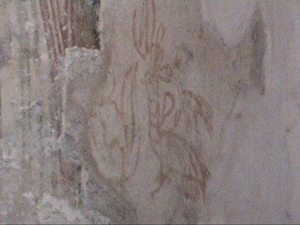Amorgos
|
|
Despite the influx of tourism
during the late 20th century, the easternmost of the |
|
|
||||||||||||||||||||||||||||||
|
|
Amorgos -unsurprisingly- has been
awarded with the "23rd European Tourism Award for Contribution in the
Development of Eco-sustainable Tourism". The Award was presented at
"3rd International Convention for Culture and Tourism "Yperia"
2005", which was hosted by the Aegialis Hotel, at Aegiali, Amorgos, |
|
|
||||||||||||||||||||||||||||||
|
|
Participating the "Yperia
2005", I had the opportunity to walk the traditional pathways of the
island with like-minded attendants of the Convention. Due to time
restrictions, I couldn't explore as much as I would like to, but enough to be
fascinated , and surely love to be one of those year-after-year- returning
visitors. That said, I returned to Amorgos
and participated the "Yperia 2006" Convention, which also took
place at the hospitable Aegialis, April 27th- 30th
2006. |
|
|||||||||||||||||||||||||||||||
|
|
The photos from 2005 included in
this page are courtesy of my colleagues Zdrafka Michailova, and Maud and
Laurent of Reporterre. I had then attended the Convention as a correspondent
of Mesogeios Radio Station, so I guess I have an excuse for not taking my own
camera along. |
|
|||||||||||||||||||||||||||||||
|
|
Walks One & Two, are classic
routes, on paths signposted by the Culture Department of the Prefecture of
the |
|
|||||||||||||||||||||||||||||||
|
|
|
|
|
||||||||||||||||||||||||||||||
|
|
Walk One: Langada - Epanochoriani - Tholos- Astratigos - Tholaria -
Lefkes Spring- Aegiali: |
|
|
||||||||||||||||||||||||||||||
|
|
Traditional villages, ravines,
beaches, springs, old churches, solitary chapels, roman tombs, pine grooves,
ancient greek and prehistoric acropolises, terraced
fields, cobblestone paths, breath-taking precipices. All ingredients of this
3-hour walk at the feet of the dominant |
|
|
||||||||||||||||||||||||||||||
|
|
The |
|
|||||||||||||||||||||||||||||||
|
|
Sitting on the dusty cottage's
benches and sipping raki with the friendly farmer, joined by two colleagues
of mine and another three Amorgean men, the company soon seemed to me like a
mini convention when the talk revolved around the future of the island. Like
the Prophets of Israel, each seemed to have a different vision: one wanted an
airport to be constructed, charter flights landing, aiming at tourism
development aggressively; another wanted a ferry-boat bought by the local
authorities, to independently handle transportation, for the island's own
good; yet another wanted his island to remain unspoiled, as unspoiled as
possible, as quiet and serene as possible; the debate went on... |
|
|||||||||||||||||||||||||||||||
|
|
To the north-east of
Epanochoriani, the trail proceeds through abandoned terraces, turning the
back to the once forested Krikelos, only to join the path between Langada and
Tholaria. Near the junction, in a small creek, the spring of Dris lays a few
steps below the ground, marked by a squat cement structure, and a groove of
trees. It is hard to imagine that as recently as 1836 the massive Mt.
Krikelos above us was still covered with its ancient pine forest, to which
the region of Aegiali owed its name "Melania" meaning "black
forest", only to give way to a huge fire burning for months. |
|
|
||||||||||||||||||||||||||||||
|
|
The path continues in direction
"Tholaria". To the right a cement water reservoir, inspires my
curiosity to look for the spring it takes water from up the cleft of the
hill. To my surprise I discover a very old, perhaps ancient, built over with
a vault, spring, which incorporates a marble greek
inscription! The inscription can be transcribed as: [...]ΙΛΟΥΜΕΝΗ
ΠΡΕΙΜΟΥ ΗΡΩΙC
ΧΡΗC [...]Η ΧΑΙΡΕ
The inscription puzzled me: if it
was still standing in its original place, then this should be an ancient
vaulted tomb, and not a vaulted spring. But then again for some reason, some when,
someone could have taken it from perhaps the ancient city of |
|
|||||||||||||||||||||||||||||||
|
|
Further on the trail, a solitary
tall ruined vaulted structure, standing on saddle at a junction of the path,
puzzled me even more. Could this be one of the roman era vaulted tombs of the
Tholaria area, as its name "Tholos" suggests? This must have then
belonged to a remarkable person of the era, as it remarkable itself and very
charming in its decay. |
|
|||||||||||||||||||||||||||||||
|
|
To the east of the Tholos, the
main trail forks towards the tiny plateau of Asratigos, with the namesake old
church standing next to a sheep-pen, which stands on the foundation walls of
a tower from the hellenistic times. In the field,
before the church, the path steps almost into the obscure mouth of an old,
built in the ground well, still in use today. Adjacent to the church, a
chapel-like structure houses human bones and numerous sculls. Inside the
church, a massive capital of the corinthian order
serves as the Agia Trapeza in the Holy Bema. This is definitely a place of
rich history. |
|
|
||||||||||||||||||||||||||||||
|
|
The parish church of the |
|
|||||||||||||||||||||||||||||||
|
|
Leaving Tholaria, the trail
descends into the valley passing from the spring of Lefkes, and ends on the
main asphalt road next to the Agii Theodori church.
Just on the beach, half way sunk into the water, the remains of roman
buildings, project from the sand. Further in the charming little |
|
|||||||||||||||||||||||||||||||
|
|
|
|
|
||||||||||||||||||||||||||||||
|
|
Walk Two: Aegiali - Potamos - Asfodilitis - Xenodochio - Chosoviotissa
Monastery - Chora: |
|
|
||||||||||||||||||||||||||||||
|
|
Amorgos boasts two things: the
millennium old renowned Monastery of Chosoviotissa, and the millions-fan' Big
Blue. This classic trail on the island, featured in just about every hiking
and general guide to the |
|
|
||||||||||||||||||||||||||||||
|
|
The Icons together with the
priests, the monks, the faithful congregation and several enthusiastic hikers
like me, set off from the parish church of the Potamos villages after the
morning Liturgy. This year this colourful company
numbered 76 people. |
|
|||||||||||||||||||||||||||||||
|
|
The youngest were elementary
school kids, running ahead the main body of the pilgrims, to ring the
churches' bells to welcome and announce the approaching Icons. Walking fast
enough, I joined the kids waiting at the Agios Mamas chapel on the ridge
above Potamos. Unsurprisingly, Agios Mamas is said to be standing on the site
of an ancient building, and curious enough I felt constrained to explore the
neighborhood, only to find some old shepherd stone huts, still furnished with
beds and closets, but obviously long abandoned. In a newspaper the kids
found, the date read |
|
|||||||||||||||||||||||||||||||
|
|
The oldest of the group, was Kyra
Rinaki, a 74 year old lady from Langada. She has been doing this trip for
ages and she does not mean to give up. "Are you sure you are going to
make it to the Monastery, Rinaki?" the younger asked her. "I will
go as far as my feet and God wants!" she replied. Kyra Rinaki was not of
the faint-hearted type. She was very lively, very talkative, and very
knowledgeable. She answered all my questions about which plant is what,
particularly about a plant that looked and smelled like oregano. She informed
me it is 'aragani' a kind of pseudo-oregano, used to adulterate the original
oregano. |
|
|||||||||||||||||||||||||||||||
|
|
For many of the pilgrims this
Procession is a "taximo" for wellness, and to emphasize their commitment,
some are even walking barefoot. They are daughters and mothers and daughters
in law, walking barefoot for the 3 hour forty min trek. |
|
|
||||||||||||||||||||||||||||||
|
|
After Agios Mamas the trail passes
from three uninhabited hamlets. I was surprised that there was a family of
farmers waiting for the Procession at the first of them, the Oxo Meria, for
the "blessing". Next is the Asfondilitis,
larger than Oxo Meria, with small grey stone houses facing south, and its
church, Agios Nikolaos, under renovation works. I looked for Kyra Rinaki to
show me the stone engravings as I was promised, only to spot her a mile
ahead! These rock carvings are supposed to have been made only a few decades
ago, but they look just like prehistoric rock designs from the cave-man era! |
|
|
||||||||||||||||||||||||||||||
|
|
Last of the three hamlets is Agrilas,
a tiny place with a few stone farmers-huts, that seemed unvisited for ages. |
|
|
||||||||||||||||||||||||||||||
|
|
Just before Xenodochio, the
company takes a rest. A great spot to enjoy the view over the north coast of
the island, the islet of Nicouria and Gramboussa,
the big blue of the |
|
|||||||||||||||||||||||||||||||
|
|
Xenodochio, meaning
"Hotel", used to be the official resting spot on this old high-way
between Chora and Aegiali. Shut and sealed today, it comprises of a few stone
huts -with some fancy accessories, I must admit-, surrounded by a large stone
fence-wall. Facing south now, the path proceeds to the Chosoviotissa. Along
this way nothing remarkable but the cliffs and the precipices, best to be
avoided by those suffering from vertigo. If only I had known better, to
follow Kyra Rinaki who diverged from the main path from Xenodochio, to visit
a number of churches higher on the way. |
|
|||||||||||||||||||||||||||||||
|
|
On reaching Chosoviotissa, the
women who wish to enter the Monastery must be dressed "appropriately",
meaning long skirts and covered busts and shoulders. |
|
|||||||||||||||||||||||||||||||
|
|
Going down the stairs from the
Monastery to the parking, I had to confront a crowd going up the opposite
way, gathering for the arrival of the Icons. Out of the parking, to the right,
the old cobblestone path, the so-called "kalogerikos" (of the
monks), ascends to the Chora. |
|
|
||||||||||||||||||||||||||||||
|
|
Maria Theologitou, a participant
of our Convention, and resident of the Chora has come with her car, to invite
us to her place. She insists so much that, to those not acquainted with the greek philoxenia, it might almost seem like kidnapping.
Maria is a young woman, who has turned their home's traditional oil-press to
a family-run hostel. She lives next to the renovated rooms she lets, where she
also runs a small taverna in summer, at the veranda of her house, overlooking
the terraced hills to the south west. In the middle, a lush garden, featuring
all kinds of season's vegetables, a variety of grapevines and fruit trees,
that Maria personally takes care of and is very proud to show everyone around. |
|
|
||||||||||||||||||||||||||||||
|
|
She is also very proud to show us
around the Chora. Her descriptions and narrations are so spontaneous and vivid,
that she even showed us the former garbage dump and the tales told about it.
The former garbage dump, at the wind-mills area, looks like an ordinary and
usual well from the outside. It has been used for generations and generations
without ever filling up. Once you remove its cover, an awful smell pours out,
and once you spell a word into its mouth, the returning echo conveys
something chaotic. It is said that a cat that once fell into it found its way
down to the |
|
|||||||||||||||||||||||||||||||
|
|
Later on, at a cafe, at the Chora's Loza, I had the good
luck to meet Mr. Simon Giannakos, the former antiquities warden of the |
|
|
||||||||||||||||||||||||||||||
|
|
|
|
|
||||||||||||||||||||||||||||||
|
|
|
|
|
||||||||||||||||||||||||||||||
|
Walk Three: The “Evangelismos
Trail”: Katapola – Xylokeratidi
– Nera – Peristera
– Nio Chorio - Evangelismos – Ftochi
Panagia – Mycenean Cemetery – Xylokeratidi. |
|
|
|||||||||||||||||||||||||||||||
|
Katapola, the main of the two ports of the
island, is itself well worth a stroll. It used to be the port of the ancient
city of It’s a pleasant easy walk to
the seaside little The springs at Nera
used to be a main source of water for the nearby inhabitants, until recent times,
and the water was reputed to be especially healthy. The springs are framed by
water holes and gutters, obviously still in use. Don’t forget to leave
the fencing gates exactly as you find them. From Nera,
the path ascends inland, and reaches a charming little farming plateau, with
fields fenced with dry-stone walls and abandoned stone cottages. To the left,
an obvious, yet unmarked fork, takes to the Lighthouse in 30 minutes. To the
right, the hill of Vigla, is the site of a
settlement of the bronze age, namely the 3rd millennium BC. The path, continues inland, and
soon reaches a ridge framed by a tiny hamlet, consisting of only three
stone-built abandoned cottages, and a couple of threshing floors. Taking a
peek through the stuttering doors into the houses, is glimpsing onto a freeze
frame of an era gone. The most stunning at this point,
is the magnificent wide view over the Katapola bay.
The path now has leveled out, and
soon reaches another cluster of abandoned stone huts, with the extravagant
name of Nio Chorio,
obviously home to farmers during harvesting times, in a not so remote past.
The cistern, is still taken care of, there is even a bucket left on top of
it. |
|
|
|||||||||||||||||||||||||||||||
|
Soon the path starts to descend in
curls, down into the verdant Several minutes down the path, a gap
in the fence wall to the right, marks the entry to the field that hosts the
remarkable The church is locked, but we were
as lucky as meeting the young caretaker just leaving, and convincing him to
let us a minute to see the frescoes inside the church. What makes this
hidden-away-in-the-valley-groves jewel-like little church all important? The church belongs to the unusual
and rare architectural type of the so-called “mausoleum”. To
describe it as simply as possible, it is a building, square in plan, with a
circular dome, which in early Christian or early Byzantine times often had a
burial character. A vaulted narthex has been added in later times. Three
layers of frescoes are preserved, the earliest assigned to the 9th
century, time of the iconoclast controversy. Evangelismos
is one of the -only- three churches on Amorgos that retain fragments of aniconic decoration. Marbles probably belonging to an
early Christian era, lay loose in the foreyard. Other marbles, possibly spolia, are incorporated in the walls. Take a close look
at the soil-wall opposite the church’s north wall, and you will face a
series of debris strata. This is an immensely interesting site! The path continues among lush
vegetation, and soon past the chapel of Ftochi
Panagia and the sign “to the This 5 km long, old path, was
restored in Spring 2005, as a pilot project undertaken by the
“Foundation Amorgos” with the financial help of a group of loyal
visitors of the island. The Project was presented at the
“Yperia 2006” by Mr. Henk Hooft, a Dutch visiting Amorgos for 27 years, and now a
home owner on the island, and a vivid advocate for restoring and maintaining
its old paths. Fifty more kilometers of old paths
in six designated routes on the island, await their sponsors to be restored
and/or maintained. On |
|
|
|||||||||||||||||||||||||||||||
|
|
|
|
|||||||||||||||||||||||||||||||
|
|
A Travelogue of Amorgos –
Historical and Cultural Guide. “Archipelagos” Cultural
Corporation, Cyclades 2001. Αμοργός:
Μια ιδέα-πείραμα που έγινε πραγματικότητα και πώς έγινε ο εθελοντικός
καθαρισμός μονοπατιών, με κέφι και ενθουσιασμό ! http://www.eposfilis.com/AMORGOS/amorgos.htm Αμοργός, Το απέραντο γαλάζιο. Επτά Ημέρες, εφ. "Η Καθημερινή", 29 Μαΐου 2005. Anastassiou T.: Amorgos, History Sightseeiing. "Archipelagos" Cultural Corporation, Hermoupolis 1996. Dubin M.: Trekking in Dubin M.S.: Graf D.: Wandern auf den Kykladen.
Dieter Graf Verlag, Muenchen 1999, s. 13-30. Μαραγκού Λ. Ι.: Αμοργός Ι. Η Μινώα, ο λιμήν και η μείζων περιφέρεια. Βιβλιοθήκη της εν Αθήναις Αρχαιολογικής Εταιρίας, αρ. 228. Αθήνα 2002. Μαραγκού Λ. Ι.: Αμοργός ΙΙ. Οι αρχαίοι πύργοι. Βιβλιοθήκη της εν Αθήναις Αρχαιολογικής Εταιρείας αρ. 239. Αθήνα 2005.
Μηλιαράκης Αντ.: Αμοργός.
Δελτίο Ιστορικής και Εθνολογικής Εταιρίας της Ελλάδος, τόμ. Α', σ. 569-656. Νίγδελης Π.Μ.: Πολίτευμα και
κοινωνία των πόλεων των Κυκλάδων κατά την ελληνιστική και αυτοκρατορική
εποχή. Θεσσαλονίκη 1990. Schoenrock D.: Amorgos und Kleine
Ostkykladen. Michael Mueller Verlag, 1997. Suhr G.: Amorgos. Richtig Wandern
Kykladen, DuMont Buchverlag, Koeln 1987, s. 226-241. |
|
|||||||||||||||||||||||||||||||
[ Hosted by Yahoo! Geocities ] [ eMail me ]
